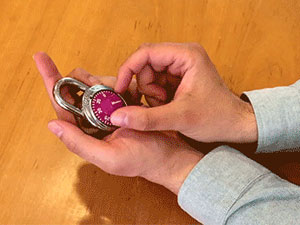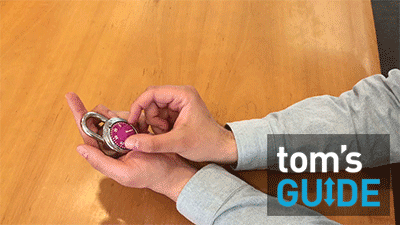See a Master Lock Get Hacked in Seconds
Hide your clothes, hide your bags: the Master Lock combination lock has been hacked. We tested the trick ourselves on a brand-new lock.


To release the shackle on a Master Lock combination lock, you typically need a sequence of three numbers, each between one and 40. There are 64,000 possible combinations you'd have to run through to brute-force one of these widely used locks -- or at least there were. Now, thanks to code published online by renowned hacker Samy Kamkar, you can narrow your options down to just eight possible sequences.
We're not recommending that you do this to someone else, but it's fascinating how simple the steps are, which we tried for ourselves on a Master Lock.
To get those selected possibilities, you'll need to input three numbers into an online calculator that Kamkar created just for this purpose. For the first and second numbers, you turn the dial to zero, pull the locked shackle out of the lock as far as it will go, and start rotating the dial counter-clockwise towards 11.
The dial will soon become stuck, and if you keep the shackle pulled out, you'll be able to rotate the dial only between two whole numbers or over one whole number. If the range is between two whole numbers (i.e. 3 to 4), you can ignore that result. If it’s between half-digits (i.e. 4.5 to 5.5 or 7.5 to 8.5), write down the whole number in the middle of the range.
That's the first number, and in order to get the second number, you release the tight grip on the shackle, and turn the dial counter-clockwise again. Once the dial gets stuck again, check the range as you just did, and now you've either got the second number, or you need to turn towards 11 one last time. Once you've got two ranges that are over whole numbers, you're done with this part of the process.
The third number you'll need is found by pulling the locked shackle half as far out as it will go, and rotating the dial clockwise. After repeated rotations, you'll find resistance at a specific number. That's your third number.
Enter these three into the calculator, and, in exchange, you'll get the first number of the combination, a handful of possibilities for the second entry in the combination and the two possibilities that exist for the last number in the combination.
Sign up to get the BEST of Tom's Guide direct to your inbox.
Get instant access to breaking news, the hottest reviews, great deals and helpful tips.
To narrow the possibilities down further, turn the dial to the first option for the third digit, pull the shackle out again as far as it will go, and see how much of a range the dial can rotate between. Repeat that step for the other number.
Whichever option had a larger range of "give" is the third number of the combination. Click on that number, and it will eliminate some of the options for the second digit, narrowing the possibilities down to the aforementioned 8 possibilities.
Here’s a video tutorial by Kamkar to explain it at regular speed:
The Master Lock-breaking code, as well as the above video, is the latest in Kamkar's Applied Hacking series. Kamkar, who has a penchant for breaking through security, is an experienced hand at this game. He's written software that can stalk targets via Google Maps' Street View, a keystroke logger in the guise of a mere USB wall charger and a method of hacking other people's drones. His titular Samy Worm accidentally took down MySpace when he tried to add a million friends to his account.
Our test of Kamkar's code proved relatively simple, with the third resistance-based number requiring more care and focus than the other two digits.
Master Lock has not issued any statement yet about this hack, but it's not the only way to break into a padlock. Entry can also be forced with a shim made from a soda can, as in a MacGyver-like hack we’ve recently seen.
- 10 Simple Tips to Avoid Identity Theft
- How to Encrypt Your Files and Folders
- Best Wireless Home Security Cameras
Henry T. Casey is a Staff Writer at Tom’s Guide. Follow him on Twitter @henrytcasey. Follow us @tomsguide, on Facebook and on Google+.

Henry is a managing editor at Tom’s Guide covering streaming media, laptops and all things Apple, reviewing devices and services for the past seven years. Prior to joining Tom's Guide, he reviewed software and hardware for TechRadar Pro, and interviewed artists for Patek Philippe International Magazine. He's also covered the wild world of professional wrestling for Cageside Seats, interviewing athletes and other industry veterans.
